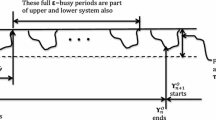Abstract
This paper studies a fluid queueing system that has a single server, a single finite buffer, and which applies a strict priority discipline to multiple arriving streams of different classes. The arriving streams are modeled by statistically independent, identically distributed random processes. A proof is presented for the highly intuitive result that, in such a queueing system, a higher priority class stream has a lower average fluid loss rate than a lower priority class stream. The proof exploits the fact that for a work-conserving queue, the fluid loss rate for a given class is invariant of what queueing discipline is applied to all arriving fluid of this particular class.
Similar content being viewed by others
References
E. Altman, T. Jimenez and G. Koole, On optimal call admission control in resource-sharing system, IEEE Trans. Commun. 49(9) (2001) 1659–1668.
D. Bertsimas, D. Gamarnik and J. Tsitsiklis, Stability conditions for multiclass fluid queueing networks, IEEE Trans. Automat. Control 41(11) (1996) 1618–1631.
D. Bertsekas and R. Gallager, Data Networks, 2nd Ed. (Prentice Hall, 1992).
N. Christin, J. Liebeherr and T.F. Abdelzaher, A quantitative assured forwarding service, in: Proc. IEEE INFOCOM 2002, Vol. 2 (2002) pp. 864–873.
B.D. Choi, B.C. Shin, K.B. Choi, D.H. Han and J.S. Jang, Priority queue with two state Markov modulated arrivals, in: Proc. IEEE ICC '96, Vol. 2 (1996) pp. 1055–1059.
J. Choe and N.B. Shroff, A central-limit-theorem-based approach for analyzing queue behavior in high-speed networks, IEEE/ACM Trans. Networking 6(5) (1998) 659–671.
J. Choe and N.B. Shroff, On the supremum distribution of integrated stationary Gaussian processes with negative linear drift, Adv. in Appl. Probab. 31(1) (1999) 135–157.
A. Elwalid and D. Mitra, Analysis, approximations and admission control of a multi-service multiplexing system with priorities, in: Proc. IEEE INFOCOM '95, Vol. 2 (1995) pp. 463–472.
A.I. Elwalid and D. Mitra, Fluid models for the analysis and design of statistical multiplexing with loss priorities on multiple classes of bursty traffic, in: Proc. IEEE INFOCOM '92, Vol. 1 (1992) pp. 415–425.
P. Fonseca, J.M. Pitts and L.G. Cuthbert, Exact fluid-flow analysis of single ON/OFF source feeding an ATM buffer with space priority, Electronics Letters 31(13) (1995) 1028–1029.
B. Hajek, Large bursts do not cause instability, IEEE Trans. Automat. Control 45(1) (2000) 116–118.
F.P. Kelly, Models for a self-managed Internet, Philosoph. Trans. Royal Soc. London A358 (2000) 2335–2348.
C. Knessl and C. Tier, A simple fluid model for servicing priority traffic, IEEE Trans. Automat. Control 45(6) (2001) 909–914.
L. Kleinrock, Queueing Systems Volume II: Computer Applications (Wiley Interscience, 1975).
J. Liebeherr, S.D. Patek and A. Burchard, Statistical per-flow service bounds in a network with aggregate provisioning, in: Proc. IEEE INFOCOM 2003, Vol. 3 (2003) pp. 1680–1690.
S.H. Low and P.P. Varaiya, Burst reducing servers in ATM networks, Queueing Systems 20 (1995) 61–84.
S.H. Low and P.P. Varaiya, A new approach to service provisioning in ATM networks, IEEE/ACM Trans. Networking 1(5) (1993) 547–553.
Y. Liu and W. Gong, On fluid queueing system with strict priority, in: Proc. IEEE Conf. on Decision and Control, Vol. 2 (2001) pp. 1923–1928.
D.C. Lee, Worst-case fraction of CBR teletraffic unpunctual due to statistical multiplexing, IEEE/ACM Trans. Networking 4(1) (1996) 98–105.
A. Narayanan and V.G. Kulkarni, First passage times in fluid models with an application to two priority fluid systems, in: Proc. IEEE IPDS '96 (1996) pp. 166–175.
H.L. Royden, Real Analysis, 3rd Ed. (Prentice-Hall, 1988).
S. Shakkottai and R. Srikant, Deterministic fluid models of congestion control in high-speed networks, in: Proc. Winter Simulations Conf., Arlington, VA (December, 2001).
B. Sericola and B. Tuffin, A fluid queue driven by a Markovian queue, Queueing Systems 31(3/4) (1999) 253–264.
L. Tassiulas and A. Ephremides, Jointly optimal routing and scheduling in packet radio networks, IEEE Trans. Inform. Theory 38(1) (1992) 165–168.
D.N.C. Tse, R.G. Gallager and J.N. Tsitsiklis, Statistical multiplexing of multiple time-scale Markov streams, IEEE J. Selected Areas in Commun. 13(6) (1995) 1028–1038.
J. Zhang, Performance study of Markov modulated fluid flow models with priority traffic, in: Proc. IEEE INFOCOM '93, Vol. 1 (1993) pp. 10–17.
Author information
Authors and Affiliations
Corresponding author
Additional information
AMS subject classification: 60K25, 68M20
Rights and permissions
About this article
Cite this article
Spitler, S.L., Lee, D.C. Proof of Monotone Loss Rate of Fluid Priority-Queue with Finite Buffer. Queueing Syst 51, 77–87 (2005). https://doi.org/10.1007/s11134-005-3749-2
Received:
Revised:
Issue Date:
DOI: https://doi.org/10.1007/s11134-005-3749-2




